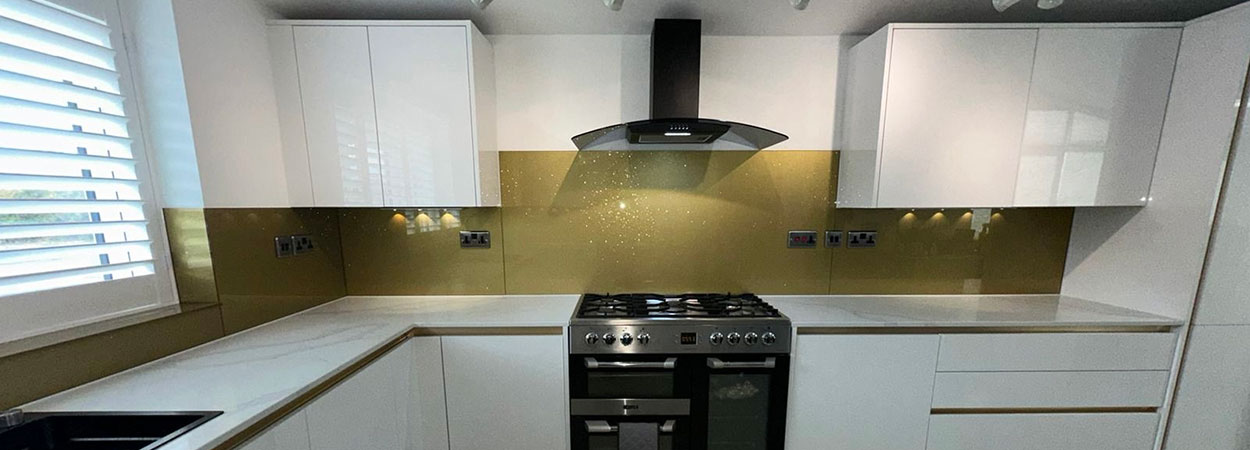
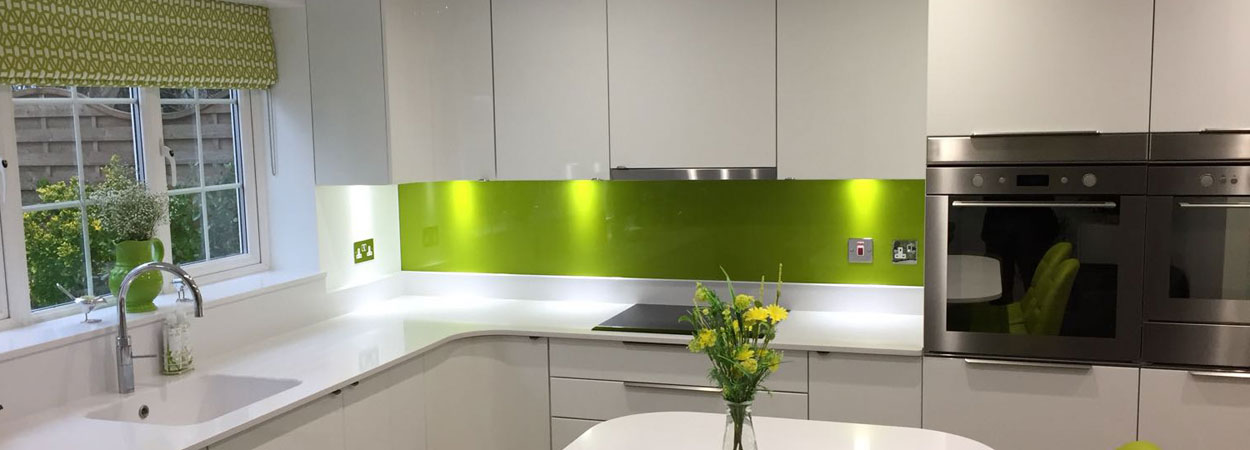
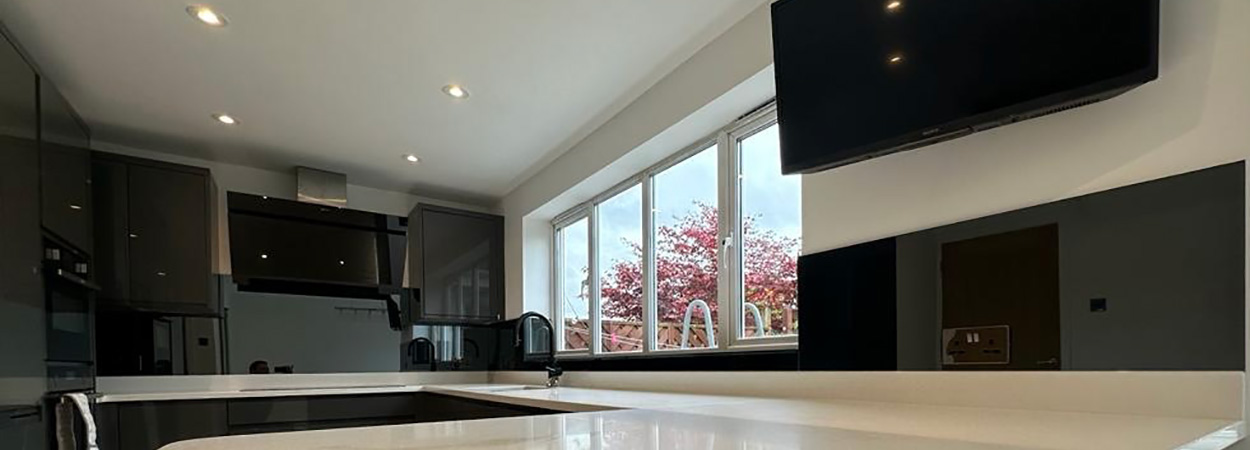
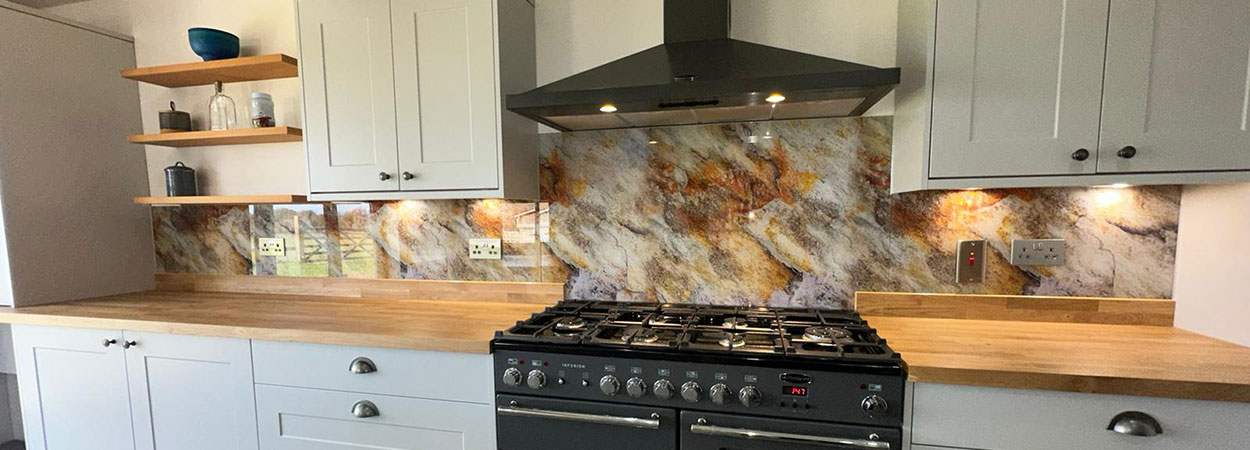
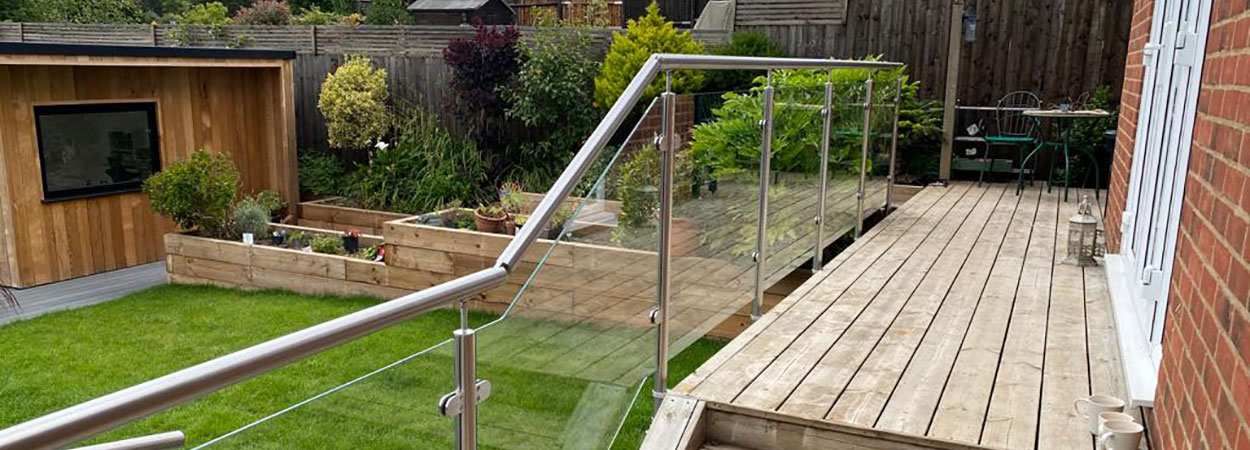
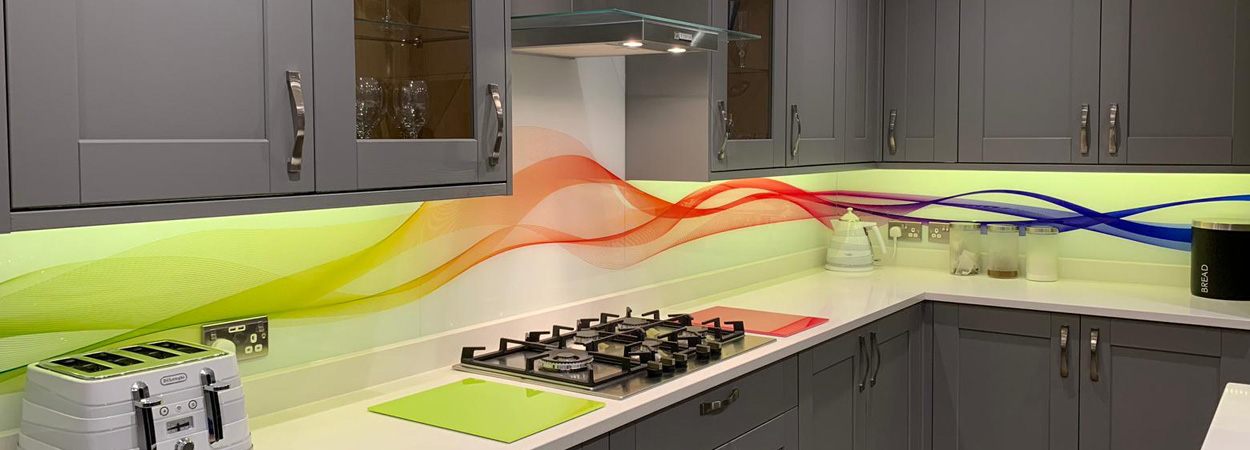


















Glass Splashbacks | Kitchen Splashbacks | Bathroom Splashbacks | Glass Balustrades | Brixton, London
Based in Stevenage, Hertfordshire, Splashbacks of Distinction have a real passion for toughened glass in and around the home. We have transformed many properties, both commercial and domestic with our glass splashbacks, for kitchens, bathrooms and living rooms. Our toughened glass balustrades, glass shelving and splashbacks with high resolution images have really caught the imagination of people who demand beauty and functionality in their homes and offices.
Glass splashbacks in Brixton
Splashbacks of Distinction are a family run, professional business that is based in Stevenage, Hertfordshire. We cover a wide area, supplying and fitting many different types of glass products and offer many premium glass related services.
Splashbacks of Distinction are happy to visit your Brixton property to discuss any glass project you may have. We can help with advice, supply and fitting of your new glass splashback or other glass products.
A little about Brixton
The name Brixton is thought to originate from Brixistane, meaning the stone of Brixi, who was a Saxon lord. Brixi is thought to have erected a boundary stone to mark the meeting place of the ancient hundred court of Surrey. The location is unknown but is thought to be at the top of Brixton Hill, at a road known at the time as Bristow or Brixton Causeway, long before any settlement in the area.
Brixton marks the rise from the marshes of North Lambeth up to the hills of Upper Norwood and Streatham. At the time the River Effra flowed from its source in Upper Norwood through Herne Hill to Brixton. At Brixton the river was crossed by low bridges for Roman roads to the south coast of Britain, now Brixton Road and Clapham Road. The main roads were connected through a network of medieval country lanes, such as Acre Lane, Coldharbour Lane, Brixton Water Lane and Lyham Road. It was only at the end of the 18th century that villages and settlements formed around Brixton.
Brixton remained undeveloped until the beginning of the 19th century, the main settlements being near Stockwell, Brixton Hill and Coldharbour Lane. With the opening of Vauxhall Bridge in 1816, improved access to Central London led to a process of suburban development. The largest single development, and one of the last in suburban character, was Angell Town, laid out in the 1850s on the east side of Brixton Road, and so named after a family that owned land in Lambeth from the late 17th century until well into the 20th century.
Brixton begins to expand
With the building of more and more bridges across the Thames in the early 19th century, those working in the City of London and the West End moved to south London. The first development was in Washway, which is now Brixton Road. With the enclosing of the Manor of Lambeth, owned at the time by the Archbishop of Canterbury, in 1806 and the opening of Vauxhall Bridge in 1816, terraced houses and detached villas started to line the main roads of Brixton.
With more recently adopted building regulations, houses had to be set further back from the main roads, allowing for gardens that were far more generous than they had been before. St Matthew's Church on part of the former common land was consecrated in 1824. The parish of St Matthew Brixton, one of five subdivisions of the ancient Lambeth parish, stretched from Camberwell Green in the northeast, to Clapham Road in the northwest, to the outer edge of Brockwell Park in the southeast and to Kingswood Road in the southwest.
Victorian expansion in Brixton
When the London sewerage system was constructed during the mid-19th century, its designer Sir Joseph Bazalgette incorporated flows from the River Effra into his 'high-level interceptor sewer', also known as the Effra sewer.
Brixton was connected to central London by rail in 1862 when Brixton and South Stockwell railway station was opened by the London, Chatham and Dover Railway on the line from Victoria. In 1866 the London, Brighton & South Coast Railway opened Loughborough Park railway station with connections to London Bridge and the following year to Victoria. With the arrival of the railways a building boom was bound to happen in and around the Brixton area. The now famous Brixton Market began in Atlantic Road and was moved to Station Road in the 1920s to ease the ever increasing traffic congestion.
A prominent building on Brixton High Street, situated at 472-488 Brixton Road, is Morleys, an independent department store that was established in the 1880s. In 1888, Electric Avenue was so named after it became the first street in London to be lit by electricity. In this time, large expensive houses were constructed along the main roads in Brixton, which were converted into flats and boarding houses at the start of the 20th century as the middle classes were replaced by an influx of the working classes.
Brixton Street made world famous
Electric Avenue is a song written, recorded and produced by the celebrated Guyanese-British singer and songwriter Eddy Grant, who released it on his 1982 album Killer on the Rampage. In the United States, with the help of the MTV video he shot for it, it was one of the biggest hits of 1983. The song refers to Electric Avenue in Brixton, and to the 1981 Brixton riot in the Brixton district of the city.
The title of the song refers to Electric Avenue in Brixton. According to Grant he first became aware of the existence of the street during his time acting at the Black Theatre of Brixton. The area is now known for its high population of Caribbean immigrants. At the beginning of the 1980s, as identified by the Scarman Report, tensions over unemployment, racism and poverty exacerbated by racist policing practices culminated in the street events now known as the 1981 Brixton riot. Grant was horrified by these events and wrote and composed a song in response to these events. Shortly after, Grant left the United Kingdom to live in Barbados, and his most recent batch of songs was lost during baggage transit. Electric Avenue was one of the songs he wrote immediately afterwards to make up for the lost material.
The Brixton Riots
Brixton was the scene of terrible rioting in April 1981 at a time when Brixton underwent deep social and economic problems, high unemployment, high crime, very poor housing and very little to no amenities. This was all concentrated into an area that was predominantly inhabited by the African-Caribbean community. The Metropolitan Police began Operation Swamp 81 at the beginning of April, aimed at reducing street crime, largely through the repeated use of the so-called sus law, which allowed police officers to stop and search any individual on the grounds of mere "suspicion" of possible wrongdoing. Plain clothes police officers were dispatched into Brixton and within five days almost 1,000 people were stopped and searched under this law. There was an understandable anger and frustration at this, since the vast majority of those stopped by the police were young black men. The riot resulted in almost 279 injuries to police and 45 injuries to members of the public, more than a hundred vehicles were burned, with more than half of these being police vehicles, and almost 150 buildings were damaged, with 30 burned. There were 82 arrests. Reports suggested that up to 5,000 people were involved in the riot.
Following the 1981 Brixton riot the Government commissioned a public inquiry into the riot headed by Lord Scarman. The subsequent Scarman report was published in November 1981 and found unquestionable evidence of the disproportionate and indiscriminate use of 'stop and search' powers by the police against black people. The report made a number of recommendations and led to a new code for police behaviour in the Police and Criminal Evidence Act 1984 and the creation of an independent Police Complaints Authority in 1985. The 1999 Macpherson Report, an investigation into the murder of Stephen Lawrence, found that recommendations of the 1981 Scarman report had been ignored and concluded that the police force was "institutionally racist".
Brixton preserves its historic windmill
One of a few surviving windmills in London, built in 1816, is just off Brixton Hill and surrounded by houses built during Brixton's industrialisation during the Victorian expansion.
Splashbacks of Distinction supply the following splashback products in Brixton, London
- Glass kitchen splashbacks
- Glass kitchen splashback samples
- Glass kitchen splashbacks in many different colours
- Printed glass splashbacks
- Colour matched splashbacks
- Painted splashbacks
Splashbacks of Distinction also supply the following glass products in Brixton, London
- Stainless steel and glass Balustrades
- Glass shelves
- Coloured mirrors
- Toughened mirrors
- Decorative glass
- Glass hardware
- Glass worktops
- Glass shower cubicle
- Garden glass balustrades
- Glass staircases
- Glass table tops
- Satin glass
- Toughened glass
- Laminated glass
- Opaque glass
Splashbacks of Distinction also supply the following glass related services in Brixton, London
- Glass cut to size
- Mirrors cut to size while you wait
- Glass processing
- Glass supply and installation
- Supply only splashbacks
- A glass express service
- Template and fit
Only the finest quality from Splashbacks of Distinction
Splashbacks of Distinction ensure that only the finest quality toughened glass is used in all our products. We guarantee all of our work and are fully insured. We employ only trained and certified engineers. Splashbacks of Distinction never leave your property without ensuring you are totally satisfied with your beautiful new glass splashback, baluster, shelving or shower enclosure.
Further Information
If you would like to know more or are interested in a quote we would be happy to help. Phone us on 01920 830 084, email us at enquiries@splashbacksofdistinction.co.uk or fill in our enquiry form and we will be in touch as soon as possible.
Areas covered in London:
- Arkley, London - Kitchen splashbacks | Bathroom splashbacks | Splashbacks with High Resolution Pictures | Glass Balustrades | Glass Shelves | Bespoke Mirrors | Bespoke Shower Screens and Enclosures | Acrylic Splashbacks | Glass splashbacks | Glass Worktops
- Barnet, London - Kitchen splashbacks | Bathroom splashbacks | Splashbacks with High Resolution Pictures | Glass Balustrades | Glass Shelves | Bespoke Mirrors | Bespoke Shower Screens and Enclosures | Acrylic Splashbacks | Glass splashbacks | Glass Worktops
- Battersea, London - Kitchen splashbacks | Bathroom splashbacks | Splashbacks with High Resolution Pictures | Glass Balustrades | Glass Shelves | Bespoke Mirrors | Bespoke Shower Screens and Enclosures | Acrylic Splashbacks | Glass splashbacks | Glass Worktops
- Beckton, London - Kitchen splashbacks | Bathroom splashbacks | Splashbacks with High Resolution Pictures | Glass Balustrades | Glass Shelves | Bespoke Mirrors | Bespoke Shower Screens and Enclosures | Acrylic Splashbacks | Glass splashbacks | Glass Worktops
- Bermondsey, London - Kitchen splashbacks | Bathroom splashbacks | Splashbacks with High Resolution Pictures | Glass Balustrades | Glass Shelves | Bespoke Mirrors | Bespoke Shower Screens and Enclosures | Acrylic Splashbacks | Glass splashbacks | Glass Worktops
- Bethnal Green, London - Kitchen splashbacks | Bathroom splashbacks | Splashbacks with High Resolution Pictures | Glass Balustrades | Glass Shelves | Bespoke Mirrors | Bespoke Shower Screens and Enclosures | Acrylic Splashbacks | Glass splashbacks | Glass Worktops
- Bexley, London - Kitchen splashbacks | Bathroom splashbacks | Splashbacks with High Resolution Pictures | Glass Balustrades | Glass Shelves | Bespoke Mirrors | Bespoke Shower Screens and Enclosures | Acrylic Splashbacks | Glass splashbacks | Glass Worktops
- Bexley Heath, London - Kitchen splashbacks | Bathroom splashbacks | Splashbacks with High Resolution Pictures | Glass Balustrades | Glass Shelves | Bespoke Mirrors | Bespoke Shower Screens and Enclosures | Acrylic Splashbacks | Glass splashbacks | Glass Worktops
- Blackheath, London - Kitchen splashbacks | Bathroom splashbacks | Splashbacks with High Resolution Pictures | Glass Balustrades | Glass Shelves | Bespoke Mirrors | Bespoke Shower Screens and Enclosures | Acrylic Splashbacks | Glass splashbacks | Glass Worktops
- Bow, London - Kitchen splashbacks | Bathroom splashbacks | Splashbacks with High Resolution Pictures | Glass Balustrades | Glass Shelves | Bespoke Mirrors | Bespoke Shower Screens and Enclosures | Acrylic Splashbacks | Glass splashbacks | Glass Worktops
- Bromley, London - Kitchen splashbacks | Bathroom splashbacks | Splashbacks with High Resolution Pictures | Glass Balustrades | Glass Shelves | Bespoke Mirrors | Bespoke Shower Screens and Enclosures | Acrylic Splashbacks | Glass splashbacks | Glass Worktops
- Buckhurst Hill, London - Kitchen splashbacks | Bathroom splashbacks | Splashbacks with High Resolution Pictures | Glass Balustrades | Glass Shelves | Bespoke Mirrors | Bespoke Shower Screens and Enclosures | Acrylic Splashbacks | Glass splashbacks | Glass Worktops
- Camberwell, London - Kitchen splashbacks | Bathroom splashbacks | Splashbacks with High Resolution Pictures | Glass Balustrades | Glass Shelves | Bespoke Mirrors | Bespoke Shower Screens and Enclosures | Acrylic Splashbacks | Glass splashbacks | Glass Worktops
- Camden, London - Kitchen splashbacks | Bathroom splashbacks | Splashbacks with High Resolution Pictures | Glass Balustrades | Glass Shelves | Bespoke Mirrors | Bespoke Shower Screens and Enclosures | Acrylic Splashbacks | Glass splashbacks | Glass Worktops
- Chadwell Heath, London - Kitchen splashbacks | Bathroom splashbacks | Splashbacks with High Resolution Pictures | Glass Balustrades | Glass Shelves | Bespoke Mirrors | Bespoke Shower Screens and Enclosures | Acrylic Splashbacks | Glass splashbacks | Glass Worktops
- Chigwell, London - Kitchen splashbacks | Bathroom splashbacks | Splashbacks with High Resolution Pictures | Glass Balustrades | Glass Shelves | Bespoke Mirrors | Bespoke Shower Screens and Enclosures | Acrylic Splashbacks | Glass splashbacks | Glass Worktops
- Chelsea, London - Kitchen splashbacks | Bathroom splashbacks | Splashbacks with High Resolution Pictures | Glass Balustrades | Glass Shelves | Bespoke Mirrors | Bespoke Shower Screens and Enclosures | Acrylic Splashbacks | Glass splashbacks | Glass Worktops
- Chingford, London - Kitchen splashbacks | Bathroom splashbacks | Splashbacks with High Resolution Pictures | Glass Balustrades | Glass Shelves | Bespoke Mirrors | Bespoke Shower Screens and Enclosures | Acrylic Splashbacks | Glass splashbacks | Glass Worktops
- Clapham, London - Kitchen splashbacks | Bathroom splashbacks | Splashbacks with High Resolution Pictures | Glass Balustrades | Glass Shelves | Bespoke Mirrors | Bespoke Shower Screens and Enclosures | Acrylic Splashbacks | Glass splashbacks | Glass Worktops
- Clapton, London - Kitchen splashbacks | Bathroom splashbacks | Splashbacks with High Resolution Pictures | Glass Balustrades | Glass Shelves | Bespoke Mirrors | Bespoke Shower Screens and Enclosures | Acrylic Splashbacks | Glass splashbacks | Glass Worktops
- Crayford, London - Kitchen splashbacks | Bathroom splashbacks | Splashbacks with High Resolution Pictures | Glass Balustrades | Glass Shelves | Bespoke Mirrors | Bespoke Shower Screens and Enclosures | Acrylic Splashbacks | Glass splashbacks | Glass Worktops
- Croydon, London - Kitchen splashbacks | Bathroom splashbacks | Splashbacks with High Resolution Pictures | Glass Balustrades | Glass Shelves | Bespoke Mirrors | Bespoke Shower Screens and Enclosures | Acrylic Splashbacks | Glass splashbacks | Glass Worktops
- Crystal Palace, London - Kitchen splashbacks | Bathroom splashbacks | Splashbacks with High Resolution Pictures | Glass Balustrades | Glass Shelves | Bespoke Mirrors | Bespoke Shower Screens and Enclosures | Acrylic Splashbacks | Glass splashbacks | Glass Worktops
- Dartford, London - Kitchen splashbacks | Bathroom splashbacks | Splashbacks with High Resolution Pictures | Glass Balustrades | Glass Shelves | Bespoke Mirrors | Bespoke Shower Screens and Enclosures | Acrylic Splashbacks | Glass splashbacks | Glass Worktops
- Dulwich, London - Kitchen splashbacks | Bathroom splashbacks | Splashbacks with High Resolution Pictures | Glass Balustrades | Glass Shelves | Bespoke Mirrors | Bespoke Shower Screens and Enclosures | Acrylic Splashbacks | Glass splashbacks | Glass Worktops
- Elm Park, London - Kitchen splashbacks | Bathroom splashbacks | Splashbacks with High Resolution Pictures | Glass Balustrades | Glass Shelves | Bespoke Mirrors | Bespoke Shower Screens and Enclosures | Acrylic Splashbacks | Glass splashbacks | Glass Worktops
- Eltham, London - Kitchen splashbacks | Bathroom splashbacks | Splashbacks with High Resolution Pictures | Glass Balustrades | Glass Shelves | Bespoke Mirrors | Bespoke Shower Screens and Enclosures | Acrylic Splashbacks | Glass splashbacks | Glass Worktops
- Enfield, London - Kitchen splashbacks | Bathroom splashbacks | Splashbacks with High Resolution Pictures | Glass Balustrades | Glass Shelves | Bespoke Mirrors | Bespoke Shower Screens and Enclosures | Acrylic Splashbacks | Glass splashbacks | Glass Worktops
- Finchley, London - Kitchen splashbacks | Bathroom splashbacks | Splashbacks with High Resolution Pictures | Glass Balustrades | Glass Shelves | Bespoke Mirrors | Bespoke Shower Screens and Enclosures | Acrylic Splashbacks | Glass splashbacks | Glass Worktops
- Fulham, London - Kitchen splashbacks | Bathroom splashbacks | Splashbacks with High Resolution Pictures | Glass Balustrades | Glass Shelves | Bespoke Mirrors | Bespoke Shower Screens and Enclosures | Acrylic Splashbacks | Glass splashbacks | Glass Worktops
- Greenford, London - Kitchen splashbacks | Bathroom splashbacks | Splashbacks with High Resolution Pictures | Glass Balustrades | Glass Shelves | Bespoke Mirrors | Bespoke Shower Screens and Enclosures | Acrylic Splashbacks | Glass splashbacks | Glass Worktops
- Greenwich, London - Kitchen splashbacks | Bathroom splashbacks | Splashbacks with High Resolution Pictures | Glass Balustrades | Glass Shelves | Bespoke Mirrors | Bespoke Shower Screens and Enclosures | Acrylic Splashbacks | Glass splashbacks | Glass Worktops
- Hackney, London - Kitchen splashbacks | Bathroom splashbacks | Splashbacks with High Resolution Pictures | Glass Balustrades | Glass Shelves | Bespoke Mirrors | Bespoke Shower Screens and Enclosures | Acrylic Splashbacks | Glass splashbacks | Glass Worktops
- Hadley Wood, London - Kitchen splashbacks | Bathroom splashbacks | Splashbacks with High Resolution Pictures | Glass Balustrades | Glass Shelves | Bespoke Mirrors | Bespoke Shower Screens and Enclosures | Acrylic Splashbacks | Glass splashbacks | Glass Worktops
- Hammersmith, London - Kitchen splashbacks | Bathroom splashbacks | Splashbacks with High Resolution Pictures | Glass Balustrades | Glass Shelves | Bespoke Mirrors | Bespoke Shower Screens and Enclosures | Acrylic Splashbacks | Glass splashbacks | Glass Worktops
- Hampstead, London - Kitchen splashbacks | Bathroom splashbacks | Splashbacks with High Resolution Pictures | Glass Balustrades | Glass Shelves | Bespoke Mirrors | Bespoke Shower Screens and Enclosures | Acrylic Splashbacks | Glass splashbacks | Glass Worktops
- Harold Wood, London - Kitchen splashbacks | Bathroom splashbacks | Splashbacks with High Resolution Pictures | Glass Balustrades | Glass Shelves | Bespoke Mirrors | Bespoke Shower Screens and Enclosures | Acrylic Splashbacks | Glass splashbacks | Glass Worktops
- Harrow, London - Kitchen splashbacks | Bathroom splashbacks | Splashbacks with High Resolution Pictures | Glass Balustrades | Glass Shelves | Bespoke Mirrors | Bespoke Shower Screens and Enclosures | Acrylic Splashbacks | Glass splashbacks | Glass Worktops
- Havering, London - Kitchen splashbacks | Bathroom splashbacks | Splashbacks with High Resolution Pictures | Glass Balustrades | Glass Shelves | Bespoke Mirrors | Bespoke Shower Screens and Enclosures | Acrylic Splashbacks | Glass splashbacks | Glass Worktops
- Hendon, London - Kitchen splashbacks | Bathroom splashbacks | Splashbacks with High Resolution Pictures | Glass Balustrades | Glass Shelves | Bespoke Mirrors | Bespoke Shower Screens and Enclosures | Acrylic Splashbacks | Glass splashbacks | Glass Worktops
- Highams Park, London - Kitchen splashbacks | Bathroom splashbacks | Splashbacks with High Resolution Pictures | Glass Balustrades | Glass Shelves | Bespoke Mirrors | Bespoke Shower Screens and Enclosures | Acrylic Splashbacks | Glass splashbacks | Glass Worktops
- Highgate, London - Kitchen splashbacks | Bathroom splashbacks | Splashbacks with High Resolution Pictures | Glass Balustrades | Glass Shelves | Bespoke Mirrors | Bespoke Shower Screens and Enclosures | Acrylic Splashbacks | Glass splashbacks | Glass Worktops
- Hillingdon, London - Kitchen splashbacks | Bathroom splashbacks | Splashbacks with High Resolution Pictures | Glass Balustrades | Glass Shelves | Bespoke Mirrors | Bespoke Shower Screens and Enclosures | Acrylic Splashbacks | Glass splashbacks | Glass Worktops
- Hornchurch, London - Kitchen splashbacks | Bathroom splashbacks | Splashbacks with High Resolution Pictures | Glass Balustrades | Glass Shelves | Bespoke Mirrors | Bespoke Shower Screens and Enclosures | Acrylic Splashbacks | Glass splashbacks | Glass Worktops
- Hounslow, London - Kitchen splashbacks | Bathroom splashbacks | Splashbacks with High Resolution Pictures | Glass Balustrades | Glass Shelves | Bespoke Mirrors | Bespoke Shower Screens and Enclosures | Acrylic Splashbacks | Glass splashbacks | Glass Worktops
- Ilford, London - Kitchen splashbacks | Bathroom splashbacks | Splashbacks with High Resolution Pictures | Glass Balustrades | Glass Shelves | Bespoke Mirrors | Bespoke Shower Screens and Enclosures | Acrylic Splashbacks | Glass splashbacks | Glass Worktops
- Islington, London - Kitchen splashbacks | Bathroom splashbacks | Splashbacks with High Resolution Pictures | Glass Balustrades | Glass Shelves | Bespoke Mirrors | Bespoke Shower Screens and Enclosures | Acrylic Splashbacks | Glass splashbacks | Glass Worktops
- Kensington, London - Kitchen splashbacks | Bathroom splashbacks | Splashbacks with High Resolution Pictures | Glass Balustrades | Glass Shelves | Bespoke Mirrors | Bespoke Shower Screens and Enclosures | Acrylic Splashbacks | Glass splashbacks | Glass Worktops
- Lewisham, London - Kitchen splashbacks | Bathroom splashbacks | Splashbacks with High Resolution Pictures | Glass Balustrades | Glass Shelves | Bespoke Mirrors | Bespoke Shower Screens and Enclosures | Acrylic Splashbacks | Glass splashbacks | Glass Worktops
- Loughton, London - Kitchen splashbacks | Bathroom splashbacks | Splashbacks with High Resolution Pictures | Glass Balustrades | Glass Shelves | Bespoke Mirrors | Bespoke Shower Screens and Enclosures | Acrylic Splashbacks | Glass splashbacks | Glass Worktops
- Mill Hill, London - Kitchen splashbacks | Bathroom splashbacks | Splashbacks with High Resolution Pictures | Glass Balustrades | Glass Shelves | Bespoke Mirrors | Bespoke Shower Screens and Enclosures | Acrylic Splashbacks | Glass splashbacks | Glass Worktops
- Mitcham, London - Kitchen splashbacks | Bathroom splashbacks | Splashbacks with High Resolution Pictures | Glass Balustrades | Glass Shelves | Bespoke Mirrors | Bespoke Shower Screens and Enclosures | Acrylic Splashbacks | Glass splashbacks | Glass Worktops
- Mortlake, London - Kitchen splashbacks | Bathroom splashbacks | Splashbacks with High Resolution Pictures | Glass Balustrades | Glass Shelves | Bespoke Mirrors | Bespoke Shower Screens and Enclosures | Acrylic Splashbacks | Glass splashbacks | Glass Worktops
- Northolt, London - Kitchen splashbacks | Bathroom splashbacks | Splashbacks with High Resolution Pictures | Glass Balustrades | Glass Shelves | Bespoke Mirrors | Bespoke Shower Screens and Enclosures | Acrylic Splashbacks | Glass splashbacks | Glass Worktops
- Notting Hill, London - Kitchen splashbacks | Bathroom splashbacks | Splashbacks with High Resolution Pictures | Glass Balustrades | Glass Shelves | Bespoke Mirrors | Bespoke Shower Screens and Enclosures | Acrylic Splashbacks | Glass splashbacks | Glass Worktops
- Peckham, London - Kitchen splashbacks | Bathroom splashbacks | Splashbacks with High Resolution Pictures | Glass Balustrades | Glass Shelves | Bespoke Mirrors | Bespoke Shower Screens and Enclosures | Acrylic Splashbacks | Glass splashbacks | Glass Worktops
- Penge, London - Kitchen splashbacks | Bathroom splashbacks | Splashbacks with High Resolution Pictures | Glass Balustrades | Glass Shelves | Bespoke Mirrors | Bespoke Shower Screens and Enclosures | Acrylic Splashbacks | Glass splashbacks | Glass Worktops
- Pinner, London - Kitchen splashbacks | Bathroom splashbacks | Splashbacks with High Resolution Pictures | Glass Balustrades | Glass Shelves | Bespoke Mirrors | Bespoke Shower Screens and Enclosures | Acrylic Splashbacks | Glass splashbacks | Glass Worktops
- Poplar, London - Kitchen splashbacks | Bathroom splashbacks | Splashbacks with High Resolution Pictures | Glass Balustrades | Glass Shelves | Bespoke Mirrors | Bespoke Shower Screens and Enclosures | Acrylic Splashbacks | Glass splashbacks | Glass Worktops
- Richmond, London - Kitchen splashbacks | Bathroom splashbacks | Splashbacks with High Resolution Pictures | Glass Balustrades | Glass Shelves | Bespoke Mirrors | Bespoke Shower Screens and Enclosures | Acrylic Splashbacks | Glass splashbacks | Glass Worktops
- Romford, London - Kitchen splashbacks | Bathroom splashbacks | Splashbacks with High Resolution Pictures | Glass Balustrades | Glass Shelves | Bespoke Mirrors | Bespoke Shower Screens and Enclosures | Acrylic Splashbacks | Glass splashbacks | Glass Worktops
- Ruislip, London - Kitchen splashbacks | Bathroom splashbacks | Splashbacks with High Resolution Pictures | Glass Balustrades | Glass Shelves | Bespoke Mirrors | Bespoke Shower Screens and Enclosures | Acrylic Splashbacks | Glass splashbacks | Glass Worktops
- St Johns Wood, London - Kitchen splashbacks | Bathroom splashbacks | Splashbacks with High Resolution Pictures | Glass Balustrades | Glass Shelves | Bespoke Mirrors | Bespoke Shower Screens and Enclosures | Acrylic Splashbacks | Glass splashbacks | Glass Worktops
- Streatham, London - Kitchen splashbacks | Bathroom splashbacks | Splashbacks with High Resolution Pictures | Glass Balustrades | Glass Shelves | Bespoke Mirrors | Bespoke Shower Screens and Enclosures | Acrylic Splashbacks | Glass splashbacks | Glass Worktops
- Sydenham, London - Kitchen splashbacks | Bathroom splashbacks | Splashbacks with High Resolution Pictures | Glass Balustrades | Glass Shelves | Bespoke Mirrors | Bespoke Shower Screens and Enclosures | Acrylic Splashbacks | Glass splashbacks | Glass Worktops
- Teddington, London - Kitchen splashbacks | Bathroom splashbacks | Splashbacks with High Resolution Pictures | Glass Balustrades | Glass Shelves | Bespoke Mirrors | Bespoke Shower Screens and Enclosures | Acrylic Splashbacks | Glass splashbacks | Glass Worktops
- Tooting, London - Kitchen splashbacks | Bathroom splashbacks | Splashbacks with High Resolution Pictures | Glass Balustrades | Glass Shelves | Bespoke Mirrors | Bespoke Shower Screens and Enclosures | Acrylic Splashbacks | Glass splashbacks | Glass Worktops
- Tottenham, London - Kitchen splashbacks | Bathroom splashbacks | Splashbacks with High Resolution Pictures | Glass Balustrades | Glass Shelves | Bespoke Mirrors | Bespoke Shower Screens and Enclosures | Acrylic Splashbacks | Glass splashbacks | Glass Worktops
- Twickenham, London - Kitchen splashbacks | Bathroom splashbacks | Splashbacks with High Resolution Pictures | Glass Balustrades | Glass Shelves | Bespoke Mirrors | Bespoke Shower Screens and Enclosures | Acrylic Splashbacks | Glass splashbacks | Glass Worktops
- Upminster, London - Kitchen splashbacks | Bathroom splashbacks | Splashbacks with High Resolution Pictures | Glass Balustrades | Glass Shelves | Bespoke Mirrors | Bespoke Shower Screens and Enclosures | Acrylic Splashbacks | Glass splashbacks | Glass Worktops
- Uxbridge, London - Kitchen splashbacks | Bathroom splashbacks | Splashbacks with High Resolution Pictures | Glass Balustrades | Glass Shelves | Bespoke Mirrors | Bespoke Shower Screens and Enclosures | Acrylic Splashbacks | Glass splashbacks | Glass Worktops
- Waltham Forest, London - Kitchen splashbacks | Bathroom splashbacks | Splashbacks with High Resolution Pictures | Glass Balustrades | Glass Shelves | Bespoke Mirrors | Bespoke Shower Screens and Enclosures | Acrylic Splashbacks | Glass splashbacks | Glass Worktops
- West Norwood, London - Kitchen splashbacks | Bathroom splashbacks | Splashbacks with High Resolution Pictures | Glass Balustrades | Glass Shelves | Bespoke Mirrors | Bespoke Shower Screens and Enclosures | Acrylic Splashbacks | Glass splashbacks | Glass Worktops
- Wimbledon, London - Kitchen splashbacks | Bathroom splashbacks | Splashbacks with High Resolution Pictures | Glass Balustrades | Glass Shelves | Bespoke Mirrors | Bespoke Shower Screens and Enclosures | Acrylic Splashbacks | Glass splashbacks | Glass Worktops
- Worcester Park, London - Kitchen splashbacks | Bathroom splashbacks | Splashbacks with High Resolution Pictures | Glass Balustrades | Glass Shelves | Bespoke Mirrors | Bespoke Shower Screens and Enclosures | Acrylic Splashbacks | Glass splashbacks | Glass Worktops

Showroom: Unit 11, Broomhall Farm, Watton At Stone, Hertford SG14 2RN
Splashbacks of Distinction is the trading name of RDC Glass Ltd




